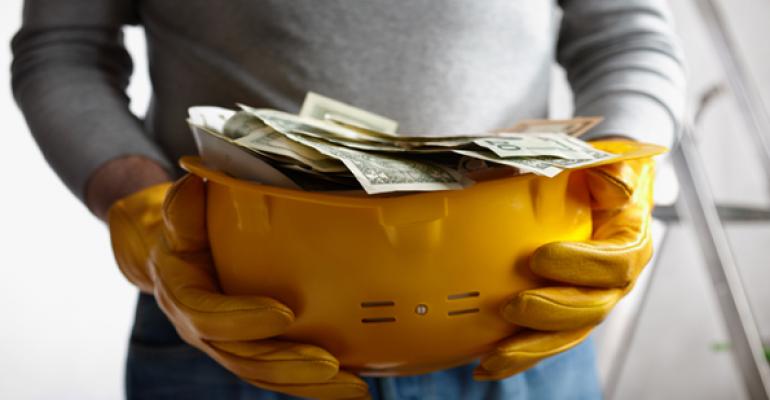The cost of construction is rising again. Trade disputes, hurricanes and rising demand from overseas are all pushing up the price of materials from gypsum wallboard to lumber and steel. And a shortage of labor is pushing construction workers’ wages higher.
“When we work with clients in their budgeting process, we are encouraging them to include a healthy contingency,” says Daryl McFarland, vice president of Sun Country Builders, a contracting company based in Vista, Calif.
So far, the price hikes have not been quite as bad as some feared earlier this year—or immediately after several major hurricanes struck late this summer. Trade disputes have not yet escalated out of control. Hurricane rebuilding projects often take years to start construction. But the cost increases right now are more than enough to stress the construction budgets of many affordable housing developers.
Material costs rise faster than inflation
The cost of materials important to the construction of apartments rose 3.6 percent over the year that ended in September, according to the producer price index (PPI) for inputs to new construction from the federal Bureau of Labor Statistics. That’s roughly twice as fast as the rate of inflation for the overall economy.
The price of wood is a big worry for apartment developers. After the Presidential election, the Trump administration threatened to add tariffs on Canadian lumber, on the grounds that the Canadian government illegally supports its timber industry. This disagreement has come up before—and the last time it did, the price of lumber more than doubled and stayed high for years.
“The administration’s tone was to take drastic action immediately,” says Ken Simonson, chief economist at the Associated General Contractors of America (AGC). So far, the U.S. has not added the tariffs. Instead, the U.S. currently seems to be threatening to take “some steps,” but it’s not clear exactly what is coming next.
Prices for lumber and plywood rose 6.8 percent over the year that ended in September. Most of those price increases came earlier this year. Lumber price actually fell slightly (0.1 percent) in September, according to the PPI.
Prices for other commodities that might be affected by trade deals and disputes have also stopped their sharp rise since the beginning of the year. For example, the price of steel mill products rose just 0.1 percent in September, after rising 7.8 percent over the previous 12 months.
“Some prices have moderated. Steel prices have backed off. Aluminum prices have backed off,” says Simonson.
Hurricanes create a shortage of gypsum wallboard
The price of gypsum wallboard has risen sharply since hurricanes tore through Texas, Florida and Puerto Rico. Prices rose 8.0 percent over the year that ended in September, according to the PPI.
It will take a lot more than just wallboard to fix the damage caused by the three hurricanes. However, wallboard prices are rising faster than the price of construction material overall. That’s because replacing wallboard damaged by water often can’t wait. Unlike timber or other building materials, wet wallboard is unlikely to dry out. It needs to be torn before black mold can grow.
Overall construction prices have not been affected by the hurricanes, however. After emergency repairs, many projects to fix up or replace damaged buildings may take years to even get started. Insurance companies, planning officials and property owners will need to agree what needs to be built or rebuilt.
In fact, immediately after the hurricanes, projects scheduled to start construction have been delayed or cancelled. “There is a pattern of decreased production immediately following natural disasters,” says Michael Neal, senior economist for the National Association of Home Builders.
Eventually, rebuilding will get underway, but the extra demand for materials from rebuilding projects will be diluted over several years and may be offset by the lost demand caused by the damage from the storms. “The hurricanes have not caused me to change my long-term forecast,” says Simonson.
The labor shortage gets worse
Meanwhile, it has become even more difficult to find workers to build apartment projects. Contractors have been forced to make do with smaller work crews and inexperienced workers, making it more difficult to complete construction on time and on budget.
“There is a substantial shortage of labor,” says McFarland. “In the last six months … we are striving to meet the schedules that we set.”
At some projects, McFarland has been forced to bring in workers from additional sub-contractors because the firms he had planned to work with were unable to supply enough labor to complete the work on time.
A surge in the construction of rental apartments has created a fierce competition for workers, similar to the bidding wars that take place for development sites. More than two-thirds of contractors report difficulty in hiring craft workers, according to an Aug. 20 survey from AGC. Carpenters are particularly hard to find. Electricians and bricklayers are also very scarce.
Tighter immigration rules are playing a part in the shortage of workers. “The construction worker visa program is not large enough to meet demand,” says Dan Markson, executive vice president of development for the NRP Group, a development, construction and property management company based in Cleveland.
Workers are hard to find partly because during the downturn many contracting companies laid off their younger employees, leaving a shortage of construction workers with mid-level experience. That’s exacerbated a long-term problem of fewer young people entering the construction trades.
“The average age of a plumber or an electrician is late 50s to early 60s as a result of the decades-long push for young people to obtain white-collar college degrees at the expense of the trades,” says Markson.





